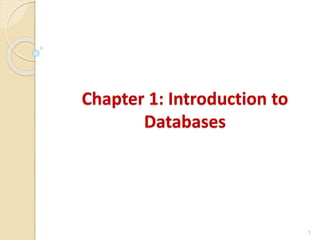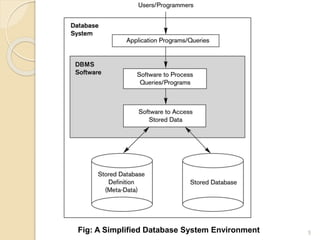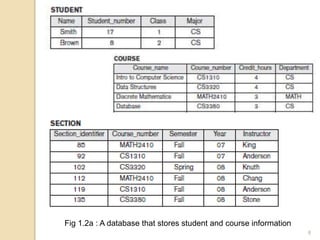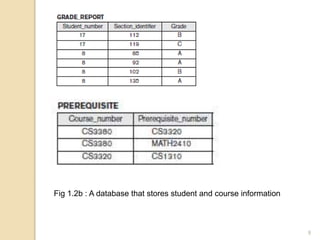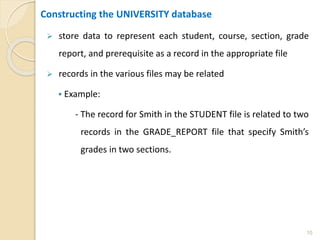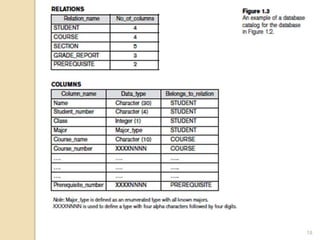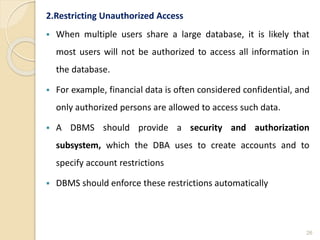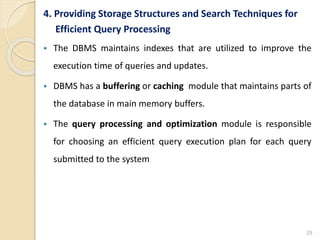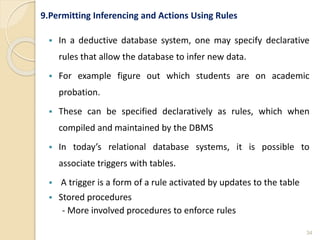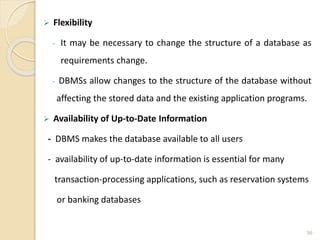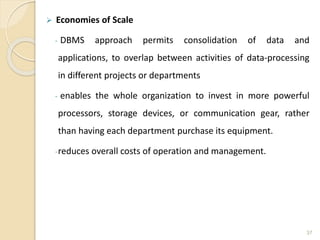Module-1 Data base management systems chap1-Introduction to database.pptx
- 1. Chapter 1: Introduction to Databases 1
- 2. Outline Introduction - Basic Definitions - Typical DBMS Functionality - Example of a Database Characteristics of the Database Approach Advantages of Using the Database Approach 2
- 3. Introduction Database: A collection of related data Data: - Known facts - implicit meaning Implicit Properties - represents some aspect of the real world, sometimes called the miniworld - logically coherent collection of data with some inherent meaning - designed, built, and populated with data for a specific purpose Database - any size and complexity - may be generated and maintained manually or it may be computerized 3
- 4. Database Management System (DBMS): General-purpose software system that facilitates the processes of - Defining - constructing - manipulating and - sharing databases among various users and applications. Functions - protecting the database: system protection security protection - maintaining it over a long period of time Database + DBMS software = Database System 4
- 5. 5 Fig: A Simplified Database System Environment
- 6. Example of a Database Mini-world for the example: • UNIVERSITY database for maintaining information concerning students, courses, and grades in a university environment • Some mini-world entities: 1.STUDENT file: record on each student 2.COURSE file: record on each course 3.SECTION file: record on each section of a course 4.GRADE_REPORT file: stores the grades 5.PREREQUISITE file : stores the prerequisites of each course 6
- 7. Defining a UNIVERSITY database Specify data elements to be stored in each record For example: • each STUDENT record includes data to represent the student’s Name, Student_number, Class, Major • each COURSE record includes data to represent the course_name, Course_number, Credit_hours and Department Specify a data type for each data element within a record For example: • student’s Name is a string of alphabetic characters • student_number is an integer 7
- 8. Fig 1.2a : A database that stores student and course information 8
- 9. Fig 1.2b : A database that stores student and course information 9
- 10. Constructing the UNIVERSITY database store data to represent each student, course, section, grade report, and prerequisite as a record in the appropriate file records in the various files may be related Example: - The record for Smith in the STUDENT file is related to two records in the GRADE_REPORT file that specify Smith’s grades in two sections. 10
- 11. Manipulating a UNIVERSITY database involves querying and updating. Examples of queries: • Retrieve the transcript—a list of all courses and grades—of ‘Smith’ • List the prerequisites of the ‘Database’ course Examples of updates : • Create a new section for the ‘Database’ course for the semester fall 2008 • Enter a grade of ‘A’ for ‘Smith’ in the ‘discrete mathematical structure’ section 11
- 12. Characteristics of the Database Approach File Processing v/s DBMS Redundancy • In traditional file processing, each user defines and implements the files needed for a specific software application as part of programming the application • For example, one user, the grade reporting office, may keep files on students and their grades • Programs to print a student’s transcript and to enter new grades are implemented as part of the application • A second user, the accounting office, may keep track of students’ fees and their payments • Although both users are interested in data about students, each user maintains separate files and programs to manipulate these files because each requires some data not available from the other user’s files 12
- 13. • Redundancy in defining and storing data results in wasted storage space and in redundant efforts to maintain common up-to-date data. • In the database approach, a single repository maintains data that is defined once and then accessed by various users. • In file systems, each application is free to name data elements independently. • In contrast, in a database, the names or labels of data are defined once, and used repeatedly by queries, transactions, and applications. 13
- 14. Fig 1.3: Database System vs. File System 14
- 15. File System: Problem Case 15 CUSTOMER file AGENT file SALES file A_Name (15 char) Carol Johnson A_Name (20 char) Carol T. Johnson AGENT (20 char) Carol J. Smith - inconsistent field name, field size - inconsistent data values - data duplication
- 16. The main characteristics of the database approach versus the file-processing approach are the following: Self-describing nature of a database system Insulation between programs and data, and data abstraction Support of multiple views of the data Sharing of data and multiuser transaction processing 16
- 17. Self-Describing Nature of a Database System Database system contains not only the database itself but also a complete definition or description of the database structure and constraints This definition is stored in the DBMS catalog The information stored in the catalog is called meta-data The catalog is used by the DBMS software and also by database users who need information about the database structure In traditional file processing, data definition is typically part of the application programs themselves. Hence, these programs are constrained to work with only one specific database, whose structure is declared in the application programs. 17
- 18. 18
- 19. Insulation between Programs and Data, and Data Abstraction Program-data independence In traditional file processing, the structure of data files is embedded in the application programs, so any changes to the structure of a file may require changing all programs that access that file. By contrast, DBMS access programs do not require such changes in most cases. The structure of data files is stored in the DBMS catalog separately from the access programs. Program-operation independence Users can define operations on data as part of the database definitions. User application programs can operate on the data by invoking these operations through their names and arguments, regardless of how the operations are implemented. 19
- 20. Data abstraction A DBMS provides users with a conceptual representation of data that does not include many of the details of how the data is stored or how the operations are implemented 20
- 21. Support of Multiple Views of the Data A database has many users, each of whom may require a different perspective or view of the database A view may be a subset of the database that is derived from the database files but is not explicitly stored For example, one user of the database may be interested only in accessing and printing the transcript of each student; the view for this user is shown in Figure below 21
- 22. Sharing of Data and Multiuser Transaction Processing A multiuser DBMS must allow multiple users to access the database at the same time. The DBMS must include concurrency control software to ensure that several users trying to update the same data do so in a controlled manner so that the result of the updates is correct. For example, when several reservation agents try to assign a seat on an airline flight, the DBMS should ensure that each seat can be accessed by only one agent at a time for assignment to a passenger. 22
- 23. Advantages of Using the DBMS Approach 1. Controlling Redundancy 2. Restricting Unauthorized Access 3. Providing Persistent Storage for Program Objects 4. Providing Storage Structures and Search Techniques for Efficient Query Processing 5. Providing Backup and Recovery 6. Providing Multiple User Interfaces 7. Representing Complex Relationships among Data 8. Enforcing Integrity Constraints 9. Permitting Inferencing and Actions Using Rules 10.Additional Implications of Using the Database Approach 23
- 24. Advantages of Using the DBMS Approach 1. Controlling Redundancy Redundancy leads to several problems- duplication, wastage of storage and data may become inconsistent. In the database approach, the views of different user groups are integrated during database design. Database design that stores each logical data item in only one place in the database. This is known as data normalization, and it ensures consistency and saves storage space 24
- 25. It is sometimes necessary to use controlled redundancy to improve the performance of queries For example, we may store Student_name and Course_number redundantly in a GRADE_REPORT file because whenever we retrieve a GRADE_REPORT record, we want to retrieve the student name and course number along with the grade, student number, and section identifier. By placing all the data together, we do not have to search multiple files to collect this data. This is known as denormalization. 25
- 26. 2.Restricting Unauthorized Access When multiple users share a large database, it is likely that most users will not be authorized to access all information in the database. For example, financial data is often considered confidential, and only authorized persons are allowed to access such data. A DBMS should provide a security and authorization subsystem, which the DBA uses to create accounts and to specify account restrictions DBMS should enforce these restrictions automatically 26
- 27. 3. Providing Persistent Storage for Program Objects object-oriented database systems make it easier for complex runtime objects to be saved in secondary storage so as to survive beyond program termination and to be retrievable at a later time. Object-oriented database systems are compatible with programming languages such as C++ and Java, and the DBMS software automatically performs any necessary conversions. 27
- 28. 4. Providing Storage Structures and Search Techniques for Efficient Query Processing The DBMS maintains indexes that are utilized to improve the execution time of queries and updates. DBMS has a buffering or caching module that maintains parts of the database in main memory buffers. The query processing and optimization module is responsible for choosing an efficient query execution plan for each query submitted to the system 28
- 29. 5. Providing Backup and Recovery The backup and recovery subsystem of the DBMS is responsible for recovery. ensures that recovery is possible in the case of a system crash during execution of one or more transactions. Disk backup is also necessary in case of a catastrophic disk failure. 29
- 30. 6 Providing Multiple User Interfaces Because many types of users with varying levels of technical knowledge use a database, a DBMS should provide a variety of user interfaces. These include - query languages for casual users - programming language interfaces for application programmers - forms and command codes for parametric users - menu-driven interfaces and natural language interfaces for standalone users. 30
- 31. 7. Representing Complex Relationships among Data A database may include numerous varieties of data that are interrelated in many ways. For example each section record is related to one course record and to a number of GRADE_REPORT records—one for each student who completed that section. A DBMS must have the capability to represent a variety of complex relationships among the data, to define new relationships as they arise, and to retrieve and update related data easily and efficiently. 31
- 32. 8.Enforcing Integrity Constraints Most database applications are such that the semantics of the data require that it satisfy certain restrictions in order to make sense. The simplest type of integrity constraint involves specifying a data type for each data item. - For example, in student table we specified that the value of Name must be a string of no more than 30 alphabetic characters. More complex type of constraint is referential integrity involves specifying that a record in one file must be related to records in other files - For example, in university database, we can specify that every section record must be related to a course record. 32
- 33. Another type of constraint specifies uniqueness on data item values, such as every course record must have a unique value for Course_number. This is known as a key or uniqueness constraint. It is the responsibility of the database designers to identify integrity constraints during database design. 33
- 34. 9.Permitting Inferencing and Actions Using Rules In a deductive database system, one may specify declarative rules that allow the database to infer new data. For example figure out which students are on academic probation. These can be specified declaratively as rules, which when compiled and maintained by the DBMS In today’s relational database systems, it is possible to associate triggers with tables. A trigger is a form of a rule activated by updates to the table Stored procedures - More involved procedures to enforce rules 34
- 35. 10 Additional Implications of Using the Database Approach Potential for Enforcing Standards - permits the DBA to define and enforce standards among database users in a large organization which facilitates communication and cooperation among various departments, projects, and users within the organization. - Standards can be defined for names and formats of data elements, display formats, report structures and so on. Reduced Application Development Time - once a database is up and running, substantially less time is generally required to create new applications using DBMS facilities 35
- 36. Flexibility - It may be necessary to change the structure of a database as requirements change. - DBMSs allow changes to the structure of the database without affecting the stored data and the existing application programs. Availability of Up-to-Date Information - DBMS makes the database available to all users - availability of up-to-date information is essential for many transaction-processing applications, such as reservation systems or banking databases 36
- 37. Economies of Scale - DBMS approach permits consolidation of data and applications, to overlap between activities of data-processing in different projects or departments - enables the whole organization to invest in more powerful processors, storage devices, or communication gear, rather than having each department purchase its equipment. -reduces overall costs of operation and management. 37
- 38. Question Bank 1. Define database and briefly explain the implicit properties of the database. 2. Discuss the main Characteristics of the database approach and how does it differ from Traditional file systems? 3. Define Database Management System. Briefly discuss the advantages of using the DBMS. 38
